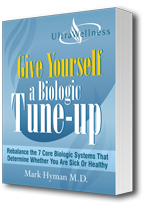Using Massage Therapy to Reduce Anxiety
 Massage refers to the manipulation of bodily muscles, tendons, connective tissue, ligaments, and even organs to help promote health often primarily through relaxation. Anxiety is often treated with cognitive behavioral therapy, medication or a combination of the two. But alternative therapies are increasingly being considered for treating anxiety, and massage is proving effective.
Massage refers to the manipulation of bodily muscles, tendons, connective tissue, ligaments, and even organs to help promote health often primarily through relaxation. Anxiety is often treated with cognitive behavioral therapy, medication or a combination of the two. But alternative therapies are increasingly being considered for treating anxiety, and massage is proving effective.
Lower Cortisol for a Calmer Self
The Mayo Clinic reports a 60-minute massage can lower cortisol, the stress hormone, by up to 30 percent after just one session.
A study published in the journal Depression and Anxiety found participants who received regular massage therapy for 12 weeks had a 50 percent reduction in anxiety symptoms. And the benefits weren’t short-lived either. Symptom reduction remained at 50 percent at the 26-week mark even after the therapy had ended.
Read more about Generalized Anxiety Disorder
In addition to its calming effects, massage therapy can help alleviate the symptoms of anxiety, including muscle tension and sleep disturbances. Experts recommend going in with an open mind and not talking or thinking about any sources of worry during the massage.
It is documented that ancient civilizations have used massage for centuries and it is still used in modern day times the world over. Though there are hundreds of types of massage, some of the most common include Acupressure, Ayurvedic, deep tissue, Esalen, medical, reflexology, Shiatsu, stone, Swedish, Thai, Traditional Chinese Medicine, Trigger Point and Visceral.
Massage has been used for centuries to help relax the body and (subsequently) the mind. Because anxiety symptoms often exhibit a chicken-and-the-egg scenario where the body and the mind are both tense and aggravating one another, massage can help to relax both body and mind. Massage is often done with essential oils:
Read more about Generalized Anxiety Disorder and Aromatherapy
Read more details about Massage Therapy
Research Evidence on Massage Therapy
Several studies indicate that massage combined with aromatherapy may be helpful for relieving anxiety.
One study evaluated this combination therapy for treating anxiety and/or depression in people undergoing treatment for cancer. The treatment did appear to provide some short-term benefits.
In a 2008 review of 27 studies, for example, researchers concluded that relaxation therapies (including Jacobson’s progressive relaxation, autogenic training, applied relaxation, and meditation) were effective against anxiety. (Although, not all of the studies were randomized, controlled trials.)
In a randomized trial involving 68 patients with generalized anxiety disorder, ten sessions of therapeutic massage, thermotherapy (application of heat), or relaxation were all found to be beneficial at reducing anxiety, though none was superior to the others.
In most cases, massage therapists combine several techniques, although there are also purists who stick to one method. The most common technique is Swedish massage, which combines long strokes and gentle kneading movements that primarily affect surface muscle tissues. Deep-tissue massage utilizes greater pressure to reach deeper levels of muscles. This may be called the “hurts-good-and-feels-great-after” approach. Shiatsu or acupressure massage also uses deep pressure, but according to the principles of acupuncture theory. Neuromuscular massage applies strong pressure to tender spots, technically known as trigger points. Reflexology is a form of foot massage based on the theory that the whole body is reflected in the foot.
Just Relax…
Don’t worry about not worrying, though, either. Instead, be prepared to test out some visualization techniques such as picturing yourself in a beautiful place, imagining yourself being completely relaxed or focusing on the areas of the body being worked on and envisioning the toxins being released. And remember, while you may experience immediate benefits, it will likely take several sessions or personal massages to start seeing a lasting difference in your anxiety. Try to incorporate a massage practice into your daily routine or schedule frequent massages. Keeping almond oil, a massage balm, or any essential oils you like around can incentivize you to keep the practice as a routine.
Flannery, Shelley. “The Incredible Benefits of Massage for Anxiety.” Zeel, 2 Apr. 2019, www.zeel.com/blog/massage/the-incredible-benefits-for-massage-on-anxiety/.
“Generalized Anxiety Disorder Overview.” FoundHealth, www.foundhealth.com/generalized-anxiety-disorder/overview.
“Generalized Anxiety Disorder and Massage Therapy.” FoundHealth, www.foundhealth.com/generalized-anxiety-disorder/generalized-anxiety-disorder-and-massage-therapy.
“Massage Relieves Depression.” Mayo Clinic Health System, www.mayoclinichealthsystem.org/hometown-health/speaking-of-health/can-massage-relieve-symptoms-of-depression-anxiety-and-stress.
Millersh. “Types of Massage Therapy to Try.” Health Essentials from Cleveland Clinic, Health Essentials from Cleveland Clinic, 2 Apr. 2021, health.clevelandclinic.org/types-of-massage-therapy-to-try/.
“Preventing Generalized Anxiety Disorder.” FoundHealth, www.foundhealth.com/generalized-anxiety-disorder/prevention#reducing-your-risk.
Sherman, Karen J, et al. “Effectiveness of Therapeutic Massage for Generalized Anxiety Disorder: a Randomized Controlled Trial.” Depression and Anxiety, U.S. National Library of Medicine, May 2010, www.ncbi.nlm.nih.gov/pmc/articles/PMC2922919/.
Join Our Community
Archives
- January 2023
- December 2022
- September 2022
- August 2022
- June 2022
- May 2022
- April 2022
- March 2022
- February 2022
- January 2022
- December 2021
- November 2021
- October 2021
- September 2021
- August 2021
- July 2021
- June 2021
- May 2021
- March 2021
- September 2020
- August 2020
- July 2020
- June 2020
- May 2020
- April 2020
- March 2020
- February 2020
Subscribe

Sign up to receive FREE toolkit
From Dr. Hyman, #1 NY Times & Amazon Author
We never spam or sell your e-mail








Follow Our Every Move